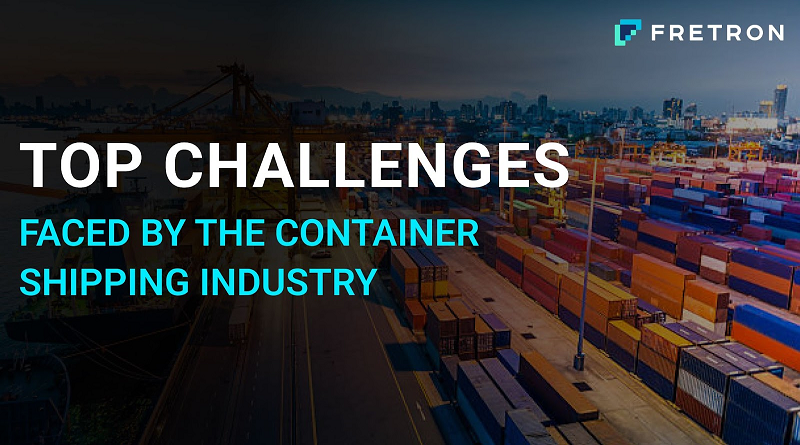The global logistics and container shipping industry plays a crucial role in the worldwide market, responsible for transporting goods and commodities across the globe. Like any other industry, it also comes with several complexities, impacting its operations, sustainability, and profitability.
Shipping container freight cost, live container tracking, container freight tracking, and shipping delays are some popular challenges in container shipping.
This blog post highlights the biggest challenges of the container shipper industry through the lens of logistics experts.
What are Shipping Containers? A Quick Overview
Shipping containers are strong and standardized metal boxes used for the transportation of goods and commodities from one destination to another. These metal containers are designed to handle long-distance transportation by ships, trains, and trucks in the container shipping industry.
Shipping containers come in several different sizes, with the most common being 20 feet and 40 feet in length. Their standardization and versatility have greatly simplified logistics operations, allowing for faster turnaround times, easier handling, and cost-effective transportation.
Biggest Challenges Faced by the Container Shipping Industry Today
Let’s have a quick overview of the biggest challenges in container logistics and supply chain management in the container shipping industry, and ways to reduce freight costs
High Freight Cost
The rise in shipping container freight costs is a major challenge in container shipment logistics. Fluctuations in fuel prices, transportation surcharges, and unpredictable market dynamics result in volatile freight rates.
Container size, weight, final terminus, and seasonal demand further impact freight costs. To manage or reduce shipping costs, enterprises need to negotiate long-term contracts with carriers to ensure competitive rates, look for consolidated shipping options, and enhance container space utilization to maximize cost efficiency.
Additionally, leveraging transportation management tools for freight rate management and partnering with freight forwarders with expertise in rate negotiations can help minimize the impact of freight cost fluctuations in container logistics.
Solution: Implementation of an automated container space optimization system that analyzes shipment volumes, container sizes, and destinations to maximize space utilization, reducing the number of empty or partially filled containers and lowering overall freight costs.
Shipping Containers Capacity
One of the primary shipping container supply chain issues is the insufficient capacity to meet the rising demand. Container shortages, limited container vessel capacity, and congested ports can result in delays, increased costs, and disruptions in the supply chain.
Enterprises must monitor capacity trends, establish strong partnerships with carriers, and find alternative shipping routes to reduce the impact of capacity constraints in container logistics.
Solution: Deployment of a container availability tracking system that integrates with port authorities and container terminals to provide real-time updates on container availability, allowing shippers to plan their shipments accordingly and avoid delays caused by container shortages.
Huge Manual Entries
Today several logistics professionals still work manually and handle the burden of paperwork and piece-together processes: Out of them, 50% find regular manual entries as “challenging” for ordinary import/export operations in the container shipping industry.
This is why automating the process is the need of the hour in container logistics. It helps in mitigating the burden of manual errors and brings more consistency to the operations workflow.
Solution: Implementation of an automated documentation system that utilizes optical character recognition (OCR) technology to scan and extract data from shipping documents, eliminating the need for manual data entry and reducing errors.
Data Accuracy
Reliability of estimated time delivery is another significant challenge for the container shipping industry. Since the introduction of digitalization in the container logistics industry, carriers and third service providers deliver additional data regarding ETA or revised date of arrival.
But this data is often corrupted by the lack of standardized data between carriers and even within the same carrier. This is due to the inefficiency of the automated system and lack of understanding of the technology.
Solution: Implementation of a data standardization framework that establishes consistent data formats and protocols for information exchange between carriers, shippers, and other stakeholders, improving data accuracy and interoperability.
High Uncertainty
Shippers are currently dealing with a significant level of uncertainty resulting from various factors such as high rates, inability to maintain logistics cost control, decreased schedule reliability, and challenge in ensuring available space on vessels.
Additionally, more than 40% of logistics professionals surveyed consider schedule reliability, container availability, and vessel space allocation as exceptionally challenging aspects of their operations in the container logistics industry.
Solution: Implementation of a dynamic routing system that continuously monitors market conditions, port congestion, and other factors to optimize shipping routes in real-time, minimizing disruptions and uncertainties in the supply chain.
Documentation and Compliance
Undoubtedly, international trade regulations are complex, and documentation requirements bring another challenge to container shipment logistics. Failure to meet compliance regulations can result in penalties, shipment delays, and cargo loss.
Leveraging customized digital platforms and automated documentation systems can simplify the documentation procedure and enhance compliance.
Solution: Development of a customized digital platform that automates the creation, validation, and submission of shipping documents, ensuring compliance with international trade regulations and reducing delays and penalties.
Lack of Real-Time Tracking
Logistic professionals find tracking and tracing their container stuffing procedure, and movement in real-time as the biggest challenge in the container industry. Obtaining real-time visibility of the location, status, and condition of containers throughout the container logistics process is possible with GPS tracking and IoT sensors.
Placing the right technology in place helps in getting accurate and timely information of container truck transport or other means of shipment in the container logistics industry.
Solution: Deployment of a centralized tracking and tracing platform that consolidates data from multiple sources, such as GPS trackers, RFID tags, and transportation management systems, allowing logistic professionals to access real-time information on container movements, estimated arrival times, and potential delays.
Technology Implementation in Reducing Challenges in Container Shipment
Let’s have a quick overview of progressive adoption of advanced technologies at different stages of the logistics process. Here’s a breakdown of these stages and the corresponding technologies:
- Pre-Shipment Stage:
- Advanced Planning Systems: Utilize algorithms and data analysis to optimize container loading, route planning, and resource allocation.
- Electronic Data Interchange (EDI): Enable the exchange of shipment-related information, such as purchase orders and invoices, electronically between various stakeholders, reducing manual paperwork and improving communication.
- Loading and Securing Stage:
- Internet of Things (IoT) Devices: Install sensors on containers to monitor and transmit real-time data, including location, temperature, humidity, and security status. This enables efficient tracking and reduces the risk of theft or damage.
- Automated Cargo Inspection Systems: Implement automated systems that use technologies like X-ray scanning and imaging to inspect cargo for security purposes, enhancing efficiency and reducing manual labor.
- Transportation Stage:
- Global Positioning System (GPS) Tracking: Employ GPS technology to track containers during transit, allowing logistics managers to monitor the location and movement of shipments in real-time.
- Blockchain Technology: Utilize distributed ledger technology to create an immutable and transparent record of container movements, contracts, and transactions. This enhances supply chain visibility, reduces fraud, and streamlines documentation processes.
- Customs and Regulatory Compliance Stage:
- Automated Documentation Systems: Implement digital platforms that facilitate electronic submission, processing, and verification of customs documents, reducing paperwork, delays, and errors.
- Artificial Intelligence (AI) for Risk Assessment: Utilize AI algorithms to analyze shipment data, identify potential risks or anomalies, and improve customs risk assessment processes.
- Last-Mile Delivery Stage:
- Route Optimization Software: Utilize algorithms to optimize delivery routes based on real-time traffic data, reducing delivery time and improving efficiency.
- Mobile Applications and Delivery Tracking: Provide mobile applications to customers and delivery personnel for real-time tracking, status updates, and communication, improving visibility and customer experience.
What’s Next?
Considering the above challenges and adopting digitalization in your shipping container logistics operations will help you enhance your overall productivity. Choosing the right tech solutions like fretron will help you access the visibility on the system, which will eventually help to improve end customers’ experience and mitigate overall container transportation costs in India and globally.



